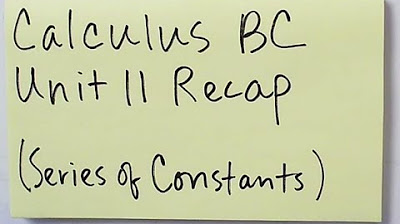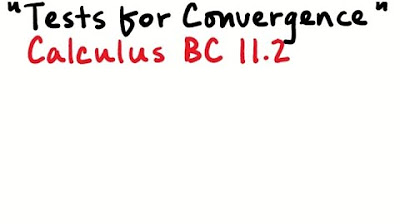Unit 10 Study Guide - AP Calculus (BC Only)
TLDRThis study guide covers Unit 10 on infinite series and sequences, focusing on determining series convergence or divergence. It includes key topics such as geometric series, p-series and harmonic series, alternating series test, ratio test for convergence, and Taylor series polynomial approximation. Each section provides the format of the series, tests to determine convergence or divergence, and relevant formulas. The guide emphasizes understanding and recognizing series formats and applying appropriate tests, with examples and a focus on major topics expected on the BC test.
Takeaways
- 📚 The study guide covers Unit 10 on infinite series and sequences, which is BC only and has been modified this year with only selected sections being tested.
- 🔍 The main focus of Unit 10 is to determine the convergence or divergence of a series, with different tests applicable for different types of series.
- 📐 For a geometric series (Section 10.2), the series is convergent if the absolute value of the ratio \( |R| \) is less than 1 and divergent if \( |R| \) is greater than or equal to 1. The sum can be found using \( S = \frac{a}{1 - R} \).
- 🎵 In the case of a p-series (including harmonic series), the series is divergent if \( P \leq 1 \) and convergent if \( P > 1 \). A harmonic series, where \( P = 1 \), is always divergent.
- 🔄 The alternating series test for convergence checks if the series terms are getting smaller and if the limit of the term as \( n \) approaches infinity is zero, indicating convergence.
- 🔢 The ratio test for convergence involves setting up a limit of the ratio of consecutive terms. Divergence is indicated if the limit is greater than 1, convergence if less than 1, and inconclusive if equal to 1.
- 📉 The script emphasizes the importance of recognizing the format of different series to apply the correct test for divergence or convergence.
- 📈 Taylor series polynomial approximation is a method to estimate the graph of a function around a certain point using a polynomial series.
- 🌐 The general term of a Taylor series includes the function evaluated at the center point, derivatives, and powers of \( (X - C) \), where \( C \) is the center of approximation.
- 🛠️ The degree of the polynomial in a Taylor series can be adjusted based on the problem's requirements, with more terms leading to a more accurate approximation.
- 📘 The study guide will include worked examples for all the series mentioned to aid understanding and application of the concepts.
Q & A
What is the main focus of Unit 10 in the study guide?
-The main focus of Unit 10 is on infinite series and sequences, specifically determining if a series is convergent or divergent.
Why is Unit 10 considered BC only?
-Unit 10 is considered BC only because it is a topic that is only touched upon in the BC test and is not generally included in the standard curriculum.
How many sections from Unit 10 are selected for the test?
-Only five sections from Unit 10 are selected for the test.
What is the general format of a geometric series?
-A geometric series generally has the format of \( a \cdot r^n \), where 'a' is a constant, 'r' is the common ratio, and 'n' is the exponent that increases by 1 with each term.
How can you determine if a geometric series is divergent?
-A geometric series is divergent if the absolute value of the common ratio 'r' is greater than or equal to 1.
What is the condition for a geometric series to be convergent?
-A geometric series is convergent if the absolute value of the common ratio 'r' is strictly less than 1.
What is the formula used to find the sum of a convergent geometric series?
-The formula to find the sum of a convergent geometric series is \( S = \frac{a}{1 - r} \), where 'a' is the first term and 'r' is the common ratio.
What is a P-series and how does its value affect convergence or divergence?
-A P-series is a series of the form \( \sum \frac{1}{n^p} \). If 'p' is less than or equal to 1, the series is divergent. If 'p' is greater than 1, the series is convergent.
What is a harmonic series and why is it always divergent?
-A harmonic series is a specific type of P-series where 'p' equals 1, represented as \( \sum \frac{1}{n} \). It is always divergent because the terms do not decrease fast enough to make the sum converge.
How does an alternating series differ from other series in terms of convergence testing?
-An alternating series tests for convergence by checking if the terms are getting smaller and smaller and if the limit of the terms as 'n' approaches infinity is zero. It does not provide information about divergence.
What is the ratio test for convergence and how does it work?
-The ratio test for convergence involves setting up a limit with the ratio of consecutive terms, \( \lim_{n \to \infty} \left| \frac{a_{n+1}}{a_n} \right| \). If the limit is greater than 1, the series diverges; if less than 1, it converges; and if equal to 1, the test is inconclusive.
What is a Taylor series and how is it used?
-A Taylor series is a polynomial series used to approximate the graph of a function around a certain point. It is represented as \( \sum_{k=0}^{\infty} \frac{f^{(k)}(c)}{k!}(x - c)^k \), where 'c' is the center of approximation and 'k' is the term index.
How does the degree of a Taylor polynomial affect its approximation accuracy?
-The degree of a Taylor polynomial affects its approximation accuracy inversely. The higher the degree, the more accurate the approximation, while a lower degree results in a less accurate approximation.
Outlines
📚 Introduction to Infinite Series and Sequences
This paragraph introduces the study guide for Unit 10, focusing on infinite series and sequences, a topic exclusive to the BC curriculum. The guide is tailored to cover only selected sections from the unit, with an emphasis on determining the convergence or divergence of series. Geometric series, characterized by a constant ratio 'R', is highlighted with its formula for convergence when the absolute value of 'R' is less than one. The paragraph also outlines the process for identifying and analyzing different types of series, such as geometric and P-series, using specific tests to ascertain their behavior.
🔍 Understanding Series Convergence Tests
The second paragraph delves into the specifics of testing for series convergence, starting with P-series, where the value of 'P' determines divergence for 'P' less than or equal to one and convergence for 'P' greater than one. It also introduces the harmonic series as a specific case of P-series with 'P' equal to one, which is always divergent. The alternating series test is explained, requiring two conditions for convergence: the terms must decrease and the limit of the terms as 'n' approaches infinity must be zero. The paragraph provides a clear method for identifying convergent series using these tests.
📉 Ratio Test for Series Convergence
This paragraph explains the ratio test, a general method for determining the convergence or divergence of a series. The test involves calculating the limit of the ratio of consecutive terms. If the limit is greater than one, the series diverges; if less than one, it converges; and if equal to one, the test is inconclusive, necessitating the use of other tests. The ratio test is presented as a versatile tool for series analysis when other tests are not applicable.
📈 Taylor Series for Function Approximation
The final paragraph introduces the concept of Taylor series as a tool for approximating functions around a specific point. The Taylor series is represented by a polynomial that includes terms derived from the function's derivatives at the center point 'C'. The general term of the series is explained, illustrating how each term corresponds to a derivative of the function evaluated at 'C', multiplied by a power of '(X - C)' and divided by the corresponding factorial. The paragraph emphasizes the utility of Taylor series in providing increasingly accurate function approximations with more terms.
Mindmap
Keywords
💡Geometric Series
💡Convergence
💡Divergence
💡P-Series
💡Harmonic Series
💡Alternating Series Test
💡Ratio Test
💡Taylor Series
💡Polynomial Approximation
💡Summation Notation
Highlights
Unit 10 focuses on infinite series and sequences, a BC-only topic with selected sections for testing.
The study guide is tailored to determine the convergence or divergence of series based on their types.
Geometric series are recognized by their format and the ratio (R) determines their convergence or divergence.
A series is convergent if the absolute value of R is less than one, divergent if greater than or equal to one.
The sum of a convergent geometric series can be calculated using the formula a / (1 - R).
P-series, including harmonic series, are identified by their base 1/n raised to a power P.
P-series are divergent if P is less than or equal to one, convergent if P is greater than one.
Harmonic series, a specific type of P-series with P equal to one, are always divergent.
Alternating series test for convergence involves checking if terms decrease and the limit of the term as n approaches infinity equals zero.
The ratio test for convergence assesses the limit of (a_(n+1) / a_n) to determine divergence, convergence, or inconclusive results.
Taylor series polynomial approximation is used to estimate the graph of a function around a certain point.
Taylor series involves the sum of terms that include derivatives of a function evaluated at a center point.
The general term of a Taylor series includes factorials, derivatives, and powers of (x - center).
The degree of the polynomial in a Taylor series determines the accuracy of the function approximation.
The study guide includes examples and exercises for each type of series to aid understanding and application.
The guide emphasizes the importance of recognizing series types and applying the correct test for convergence or divergence.
Understanding the properties of R, P, and the behavior of terms is crucial for analyzing series in this unit.
The study guide is designed to be straightforward, aligning with the sections and tests of the BC curriculum.
Transcripts
Browse More Related Video
5.0 / 5 (0 votes)
Thanks for rating:





